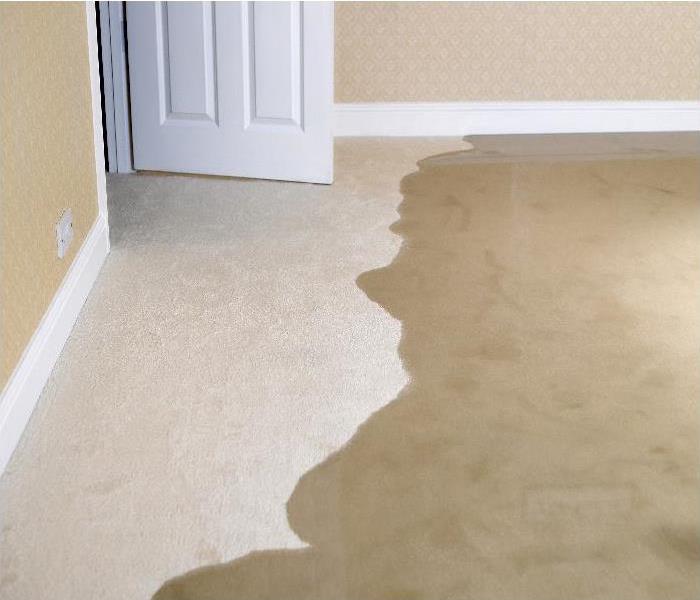How Sensitive Are Wood Floors to Water Damages in Nampa?
9/12/2020 (Permalink)
Standing water and moisture threats can become destructive to exposed wood flooring in your Nampa home, ultimately requiring removal and replacement.
The flooring in your Nampa home can often be one of the worst affected areas after a water disaster. The pooling of water can often occur along these materials, allowing for absorption in sensitive surfaces like wood and carpeting. Low permeance materials for flooring and other construction needs are often expensive, making their use sparse when building modern homes. Exposure to wood flooring can be destructive without immediate attention from water restoration companies like our SERVPRO team. Our fast response in these crises ensures the structural elements receive the attention they require after a water disaster.
When any of the structural elements in your home become impacted by exposure, water damage repair for Nampa properties becomes inevitable. Before we can determine what steps might be necessary to restore or repair damaged wood flooring, we must first understand how severe it has become. We use advanced technologies and devices like thermal imagery, hygrometers, and moisture meters to identify damp pockets and the concentration of water damage beyond the surface. This is vital to determine when the water has moved beyond wood planks and affects subflooring material. Understanding the collected data hinges on a knowledge of the three primary water states when damaging wood flooring or framework.
Free – Surface damages are often the easiest to address and can get removed with conventional extraction and specialty squeegee wands. In this state, water has yet to alter any aspect of the wood.
Trapped – When water begins to absorb into the individual planks that make up flooring, this penetration can become the initial stages of more destructive damage. Trapped moisture can also often get removed with specialty equipment like floor mat drying systems.
Bound – When water molecules bond with the composition of wood, swelling, and other distortion occurs. Often, the initial signs for wood flooring are warping around the seams at the individual plank's edges. Once moisture has become bound to the wood, there are no other options than to remove the damaged materials and replace them.
Do Finishes on Floors Affect Permeance?
Coatings and finishes on wood flooring can often add a layer of protection against moisture penetration and absorption. Finished flooring becomes less permeable to water based on the material used to provide a polished finish. Over a prolonged period, the exposure of water can dull a sheen on plank flooring, requiring cleaning with thymol or citrus-based cleansers to restore its shine. Some of the most common finishes on the hardwood flooring and other wood surfaces include:
• Varnish
• Oil-Based Finish
• Polyurethane
• Shellac
What Are Signs Wood Flooring Needs Replacing?
Your flooring can tell you a lot about the damage that it receives from saturation and water exposure. Regardless of the restorative actions required to recover the rest of the property, more extended periods of exposure with the flooring materials often require removal and replacement. The damage to your floors can be more easily identified with understanding the severity of present water and moisture. While discovery devices like moisture meters are vital in the job scoping phase, they can also help to continually monitor the progress of drying and even the deterioration of materials based on longer periods of oversaturation. Physical signs that bound water exists can be:
• Swelling
• Distortion
• Warping
Can Controlled Demolition Save Money?
The practice of only removing the damaged portions of flooring and wall systems can reduce the number of materials that must get replaced. Ultimately, controlled demolition practices can make reconstruction and repair more efficient by preparing the installation site entirely for the build-back with defined moisture drylines.
Is Mold a Threat After Water Damages?
With any water loss situation, the threat of mold and microbial growth should not get ignored. In as little as 48 hours of exposure, sensitive organic matter like drywall, wood flooring, and underlying materials can facilitate colonies. Drying can take several days, especially with hardwoods, making the possibilities of fungal colonization something our SERVPRO team must prepare to face. We have a roster of qualified mold remediation specialists who can respond with our water restoration technicians. In some situations, further demolition might be required even without oversaturation concerns when mold colonies have become a severe threat.
Water disasters can quickly get out of control and pool along flooring surfaces. With semi-porous wood materials, it is not unlikely for these elements to become damaged after a disaster. Give our SERVPRO of Nampa / Caldwell team a call to help anytime at (208) 466-5000.

 24/7 Emergency Service
24/7 Emergency Service
